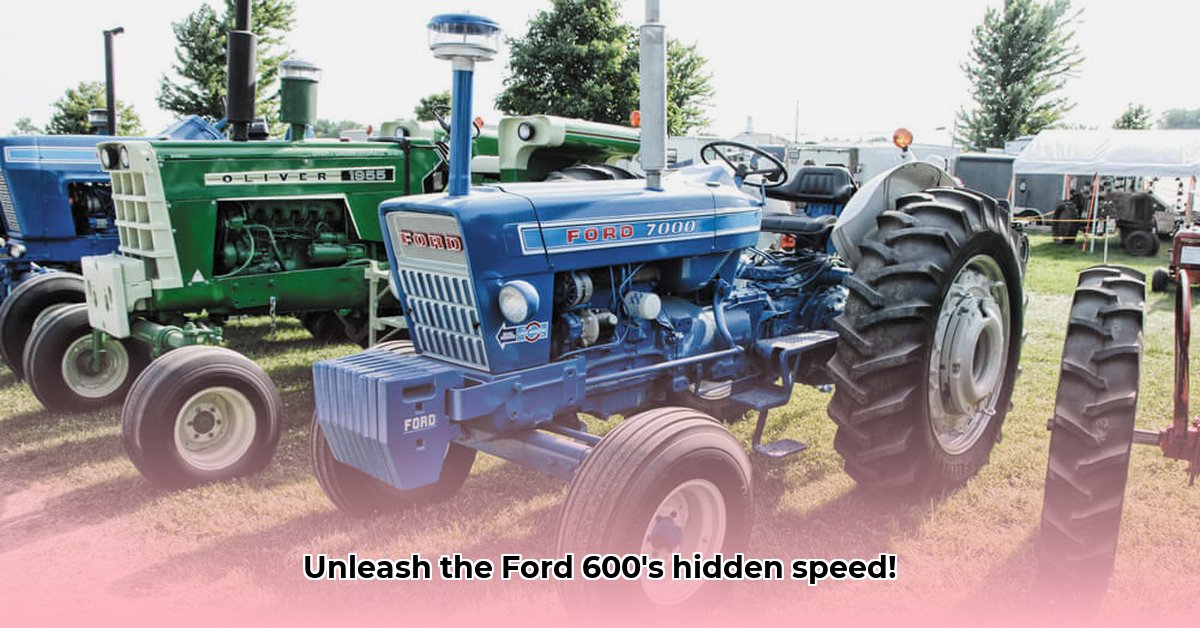
Understanding the Ford 600's Speed: A Complex Question
The Ford 600 series tractors, manufactured between 1954 and 1957, are agricultural icons renowned for their durability and the power of their 134 cubic inch Red Tiger engine (approximately 31 horsepower). However, determining a precise top speed for these machines proves surprisingly challenging. Unlike modern tractors with readily available specifications, consistent speed data across all Ford 600 models (620, 630, 640, 650, 660) is scarce due to less-standardized record-keeping practices of that era. For more detailed specifications, check out this Ford 600 specs.
While definitive top speed figures remain elusive for most models, anecdotal evidence from online tractor enthusiast communities suggests a range of 14 to 16 miles per hour (mph). However, this figure is heavily influenced by several key variables. One significant factor is the transmission type: Ford 600 tractors were equipped with either a 4-speed or a 5-speed transmission, drastically altering their performance characteristics depending on the selected gear. This is analogous to the effect of different gears in a modern car, where lower gears provide increased power for demanding tasks while higher gears optimize for speed on level terrain. The available data on the Ford 640 model, for example, illustrates this point, showing speeds ranging from 3.13 mph to 11.55 mph depending on the gear. This highlights the Ford 600's design prioritization of power and drawbar pull over high top speeds.
Further complicating matters is the variability within the 600 series itself. Models differed in features like the inclusion (or absence) of a Power Take-Off (PTO) system (used to power farm implements) and a three-point hitch, both of which would have affected overall performance. Therefore, attributing a single top-speed figure to the entire Ford 600 series would be inaccurate and misleading.
Key Specifications and Data Gaps
The following table summarizes the currently available information and the critical data gaps hindering a comprehensive understanding of the Ford 600's top speeds:
| Feature | Known Information | Unknown/Needs Further Research |
|---|---|---|
| Production Years | 1954-1957 | N/A |
| Engine | 134 cubic inch Red Tiger (approx. 31 horsepower) | N/A |
| Transmissions | 4-speed and 5-speed options available | Precise gear ratios for all models and effect on top speed |
| Top Speed (mph) | Estimates range from 14 to 16 mph (depending on model & gear) | Precise top speed for each specific model (partial data for 640) |
| PTO and Three-Point Hitch | Present on some models, absent on others | Exact model-specific availability and its performance impact |
Isn't it fascinating how much we still don't know about this seemingly simple aspect of a classic tractor? Further research, including an examination of original owner's manuals, factory archives, and interviews with experienced Ford 600 owners, is crucial to complete the picture. This includes analyzing gear ratios to understand their impact on speed in each gear. This research is vital not only for historical accuracy but also for the benefit of current owners and enthusiasts.
Actionable Intelligence: Next Steps for Research
To improve our understanding of the Ford 600's top speed capabilities, the following steps are necessary:
Systematic archival research: Examine Ford's historical records to find original specifications and performance data for each model within the 600 series.
Owner interviews: Gather firsthand accounts from individuals who operated Ford 600 tractors during their operational years (1954-1957). These testimonies can provide valuable insights into real-world performance under varying conditions.
Gear ratio analysis: Determine the precise gear ratios for each transmission variant (4-speed and 5-speed) across every model to accurately calculate potential top speeds in different gears.
Comparative analysis: Compare the obtained data with similar contemporary tractors from other manufacturers to establish a more comprehensive understanding of the Ford 600's performance within its historical context. This contextualization will improve the overall accuracy of the historical assessment.
This research will enable us to create a comprehensive and accurate guide providing a definitive answer to the question of the Ford 600 tractor's top speed, while enriching our understanding of this important piece of agricultural history.